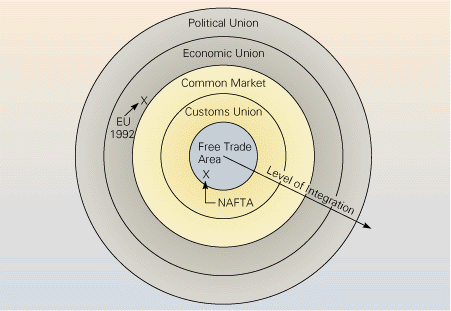Texts belong to their owners and are placed on a site for acquaintance.
Levels of Economic Integration
Several levels of economic integration are possible in theory (see Figure 8.1). From least integrated to most integrated, they are a free trade area, a customs union, a common market, an economic union, and, finally, a full political union.
Free Trade Area
In a free trade area, all barriers to the trade of goods and services among member countries are removed. In the theoretically ideal free trade area, no discriminatory tariffs, quotas, subsidies, or administrative impediments are allowed to distort trade between members. Each country, however, is allowed to determine its own trade policies with regard to nonmembers. Thus, for example, the tariffs placed on the products of nonmember countries may vary from member to member.
The most enduring free trade area in the world is the European Free Trade Association (EFTA). Established in January 1960, EFTA currently joins four countries--Norway, Iceland, Liechtenstein, and Switzerland--down from seven in 1995 (three EFTA members, Austria, Finland, and Sweden, joined the EU on January 1, 1996). EFTA was founded by those Western European countries that initially decided not to be part of the European Community (the forerunner of the EU). Its original members included Austria, Britain, Denmark, Finland, and Sweden, all of whom are now members of the EU. The emphasis of EFTA has been on free trade in industrial goods. Agriculture was left out of the arrangement, each member being allowed to determine its own level of support. Members are also free to determine the level of protection applied to goods coming from outside EFTA. Other free trade areas include the North American Free Trade Agreement.
Figure 8.1
Levels of Economic Integration

Customs Union
The customs union is one step further along the road to full economic and political integration. A customs union eliminates trade barriers between member countries and adopts a common external trade policy. Establishment of a common external trade policy necessitates significant administrative machinery to oversee trade relations with nonmembers. Most countries that enter into a customs union desire even greater economic integration down the road. The EU began as a customs union and has moved beyond this stage. Other customs unions around the world include the current version of the Andean Pact (between Bolivia, Colombia, Ecuador, and Peru). The Andean Pact established free trade between member countries and imposes a common tariff, of 5 to 20 percent, on products imported from outside.2
Common Market
Like a customs union, the theoretically ideal common market has no barriers to trade between member countries and a common external trade policy. Unlike a customs union, a common market also allows factors of production to move freely between members. Labor and capital are free to move because there are no restrictions on immigration, emigration, or cross-border flows of capital between member countries. The EU is currently a common market, although its goal is full economic union. The EU is the only successful common market ever established, although several regional groupings have aspired to this goal. Establishing a common market demands a significant degree of harmony and cooperation on fiscal, monetary, and employment policies. Achieving this degree of cooperation has proven very difficult. Currently, MERCOSUR, the South America grouping of Argentina, Brazil, Paraguay, and Uruguay, hopes to eventually establish itself as a common market.
Economic Union
An economic union entails even closer economic integration and cooperation than a common market. Like the common market, an economic union involves the free flow of products and factors of production between member countries and the adoption of a common external trade policy. Unlike a common market, a full economic union also requires a common currency, harmonization of members' tax rates, and a common monetary and fiscal policy. Such a high degree of integration demands a coordinating bureaucracy and the sacrifice of significant amounts of national sovereignty to that bureaucracy. There are no true economic unions in the world today, but the EU is clearly moving in this direction, particularly given the plans to create a single EU currency, the euro, by January 1, 2002.
Political Union
The move toward economic union raises the issue of how to make a coordinating bureaucracy accountable to the citizens of member nations. The answer is through political union. The EU is on the road toward political union. The European Parliament, which is playing an ever more important role in the EU, has been directly elected by citizens of the EU countries since the late 1970s. In addition, the Council of Ministers (the controlling, decision-making body of the EU) is composed of government ministers from each EU member. Canada and the United States provide examples of even closer degrees of political union; in each country, independent states were effectively combined into a single nation. Ultimately, the EU may move toward a similar federal structure.